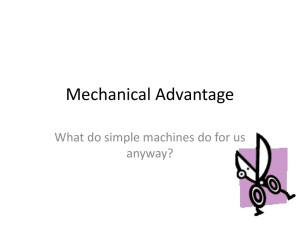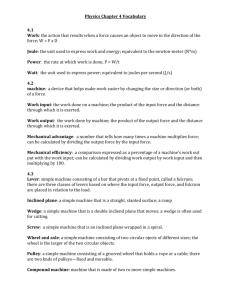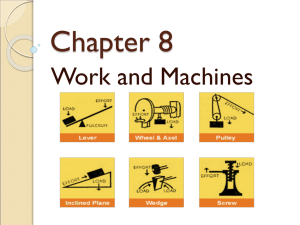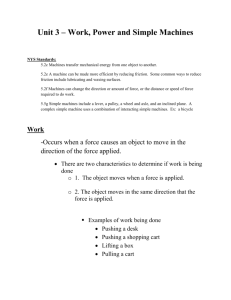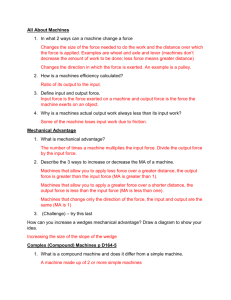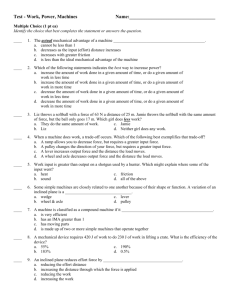Chapter 14 Work, Power, and Machines 14.1 Work and Power Work
advertisement
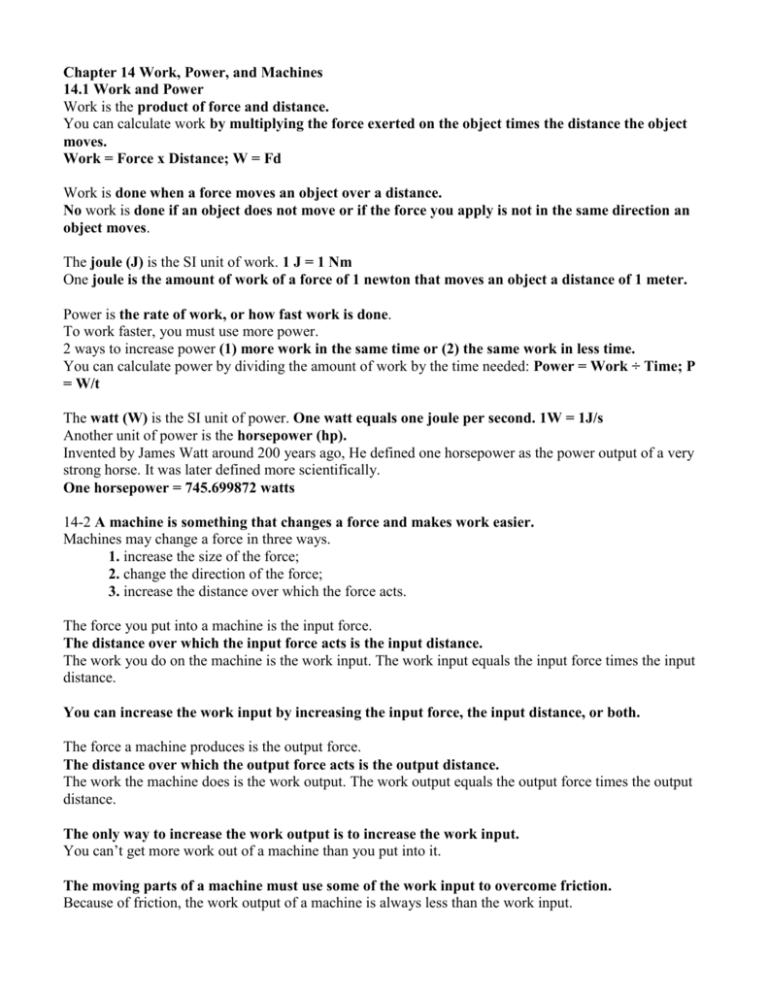
Chapter 14 Work, Power, and Machines 14.1 Work and Power Work is the product of force and distance. You can calculate work by multiplying the force exerted on the object times the distance the object moves. Work = Force x Distance; W = Fd Work is done when a force moves an object over a distance. No work is done if an object does not move or if the force you apply is not in the same direction an object moves. The joule (J) is the SI unit of work. 1 J = 1 Nm One joule is the amount of work of a force of 1 newton that moves an object a distance of 1 meter. Power is the rate of work, or how fast work is done. To work faster, you must use more power. 2 ways to increase power (1) more work in the same time or (2) the same work in less time. You can calculate power by dividing the amount of work by the time needed: Power = Work ÷ Time; P = W/t The watt (W) is the SI unit of power. One watt equals one joule per second. 1W = 1J/s Another unit of power is the horsepower (hp). Invented by James Watt around 200 years ago, He defined one horsepower as the power output of a very strong horse. It was later defined more scientifically. One horsepower = 745.699872 watts 14-2 A machine is something that changes a force and makes work easier. Machines may change a force in three ways. 1. increase the size of the force; 2. change the direction of the force; 3. increase the distance over which the force acts. The force you put into a machine is the input force. The distance over which the input force acts is the input distance. The work you do on the machine is the work input. The work input equals the input force times the input distance. You can increase the work input by increasing the input force, the input distance, or both. The force a machine produces is the output force. The distance over which the output force acts is the output distance. The work the machine does is the work output. The work output equals the output force times the output distance. The only way to increase the work output is to increase the work input. You can’t get more work out of a machine than you put into it. The moving parts of a machine must use some of the work input to overcome friction. Because of friction, the work output of a machine is always less than the work input. 14 3 Mechanical Advantage and Efficiency Mechanical Advantage: The number of times a machine increases the size of the input force. 2 types of mechanical advantage 1. The Ideal Mechanical Advantage (IMA) of a machine is the mechanical advantage WITHOUT friction. IMA = din / dout 2. Actual Mechanical Advantage (AMA) of a machine is the ratio of output force to input force. AMA = Fout / Fin Friction is always present, so the AMA of a machine is always less than the ideal mechanical advantage. Some of the work input to any machine must be used to overcome friction. Efficiency: The percentage of work input that becomes work output is the efficiency of a machine. The efficiency of a machine is always less than 100 percent. The formula for calculating efficiency is Efficiency = (Work output / Work input) x 100% If the efficiency of a machine is 75 percent: * 75 percent of the work input becomes work output. * 25 percent of work input is used to overcome friction. Reducing friction increases the efficiency of a machine. With less friction, more of the work input becomes work output. 14.4 Simple Machines Six different types of simple machines: Lever, Wheel and Axle, Inclined Plane, Wedge, Screw, and Pulley. A Lever is a stiff bar that can move around a fixed point (the fulcrum). IMA of a lever: the input arm divided by the output arm. Input Arm: the distance between the input force and the fulcrum. Output Arm: the distance between the output force and the fulcrum. Levers are classified into three categories: Based on the locations of the input force, the output force, and the fulcrum. • First-Class Levers — fulcrum between input force and output force (example: seesaw) • Second-Class Levers — output force between input force and fulcrum (example: wheelbarrow) • Third-Class Levers — input force between fulcrum and output force (example: baseball bat) A wheel and Axle: a larger outer disk attached to a smaller inner cylinder. When you turn the large wheel, the narrow axle also turns; example: steering wheel. The outer disk is the wheel, and inner cylinder is the axle. Mechanical Advantage (wheel and axle): the radius of the disk of the input force divided by the radius of the disk of the output force. Inclined Plane: a slanted surface used to move an object to a different height; example: A wheelchair ramp. IMA (inclined plane) divide the distance of the inclined plane by its change in height. For example, a 6-meter-long ramp that gains 2 meter of height has an IMA of 3 (6m ÷ 2m). Wedges and Screws are similar to inclined planes (all have sloping surfaces). However, wedges and screws have sloping surfaces that move. Wedge is a V-shaped object. The two sides of the V are inclined planes that slope to a point. IMA of a wedge depends on its shape. *A thin wedge has a greater IMA then a thick wedge of the same length. A screw is an inclined plane wrapped around a cylinder. The turns of the inclined plane around the cylinder are called threads. The IMA of a screw depends on the closeness of the threads. The closer the threads are, the greater the IMA is. Pulley: a simple machine that consists of a rope that fits into a groove in a wheel that may be fixed or movable. A Fixed Pulley: the wheel is attached in a fixed location. A fixed pulley changes the direction, but not the size, of the input force. A Movable Pulley: attached to the object being moved. A movable pulley changes both the direction and the size of the input force. A Pulley System: two or more individual pulleys, both fixed and movable. The IMA of a Pulley or Pulley System depends on the number of rope sections supporting the object being lifted. More individual pulleys have a larger IMA. Most of the machines you use every day are made up of more than one simple machine. Compound Machine: a combination of two or more simple machines that operate together. Scissors are an example of a compound machine. Each blade of a pair of scissors is a wedge, and the two blades work together as levers. Some compound machines, such as washing machines and clocks, contain dozens of simple machines.


